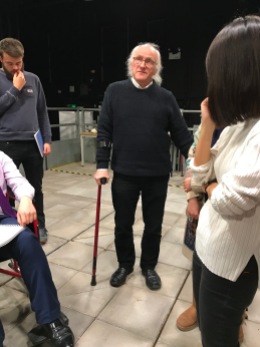
PAMELA in action. Image from http://www.ucl.ac.uk/transport-institute/lab/PAMELA
My research supervisor in London, Professor Nick Tyler, is a global expert in transportation systems, with expertise in accessibility. He travels around the world advising transportation planners–and his research also has gone a long way to improve how Transport for London serves people with mobility challenges and various forms of disability.
Transportation Design

A view from the testing platform, with Professor Tyler and some MSc students.
Nick offered a Masters-level class at University College London in Term 2 and I got to attend the opening day which was held at the research facility he heads, located on the Northern Line up in Tufnell Park.
On the opening day of this course on design for transport engineers, Nick’s students and I experienced what it’s like to navigate common street conditions while blindfolded, hearing impaired, or using crutches and wheelchairs.
The photo gallery provides a glimpse of this opening day. And, YES, it did feel like Back to the Future with Dr. Emmett Brown, who you likely remember as “Doc.”
About PAMELA
PAMELA stands for “Pedestrian Accessibility Movement Environment Laboratory.” The lab’s website explains that “PAMELA is a multisensory laboratory for the assessment of pedestrian movement.” In other words, it is a research facility with equipment for simulating real-world conditions at full scale so researchers can study how people with differing abilities deal with specific variables (sounds, ambient noise, varying light levels, tripping hazards, steps, etc.).
“Constructed between 2003 and 2006, the PAMELA laboratory is a novel and highly flexible facility,” UCL’s PAMELA webpage explains, “allowing full-scale pedestrian infrastructure to be built and tested to enable thorough assessment and evaluation. The structure includes a flexible floor surface that represents real ground conditions with interchangeable surface materials and is supported by a range of sensing equipment.” The webpage also describes specific research studies that have made a tremendous difference and yielded huge financial savings in London.

Transport simulation research being done at PEARL. Image from http://www.engineering.ucl.ac.uk/news/pamela-develop-pearl/
Introducing PAMELA’s sister, PEARL
In 2017, Nick secured a £9m grant from EPSRC via its UK Collaboratorium for Research on Infrastructure and Cities (UKCRIC) program. This will fund the construction of a new and improved version of PAMELA, called PEARL (People-Environment-Activity Research Laboratory).
Connecting UCL and DIT
In May, during my two visits to Dublin Institute of Technology (DIT), I learned that my colleagues at DIT’s transportation engineers, led by Dr. Lorraine D’Arcy, received validation to launch a new, interdisciplinary Master of Science (MSc) degree in Transport and Mobility. I look forward to helping Lorraine connect with Nick so she and DIT can learn from–and hopefully, contribute to–the wealth of experience and knowledge Nick has accrued.

Image from DIT’s website on Transport Engineering






What a life you are leading!! Exciting indeed. Larry
LikeLike
Thanks, Larry. Always great to hear from you!
LikeLike